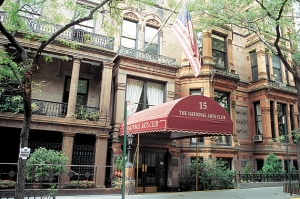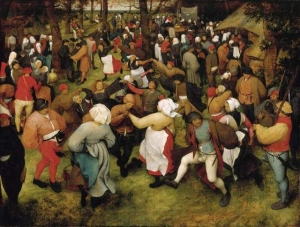|
Displaying items by tag: nonprofit
Earlier this year, the Institute of Contemporary Art got disappointing news: It would no longer be in charge of painting the massive Dewey Square wall mural, at the head of the Rose Fitzgerald Kennedy Greenway. The job would instead go to the more mainstream Museum of Fine Arts.
Jill Medvedow, ICA director, was not pleased. “Really?” she said. “It’s walking distance to the ICA.”
Other Greenway changes, perhaps more universally welcomed, are in the works. On Wednesday the nonprofit funder ArtPlace will announce a $250,000 public art grant for the Greenway, a 15-acre network of parks in downtown Boston. That follows by just a few days the announcement of plans for a $1 million public art expansion that will include the installation next year of a huge, billowing fabric work meant to hover over the park, by Brookline-based artist Janet Echelman. The Greenway is even hiring its own art curator.
The temperature was just above freezing last week, so Joshua Prager threw on a fourth blanket. He was glad to be here, sleeping in the creaky barn built on a sand dune a century ago by painter Charles Hawthorne. This spot on Miller Hill Road, a short walk to Commercial Street, is where many say this storied peninsula got its start as an art colony.
Norman Rockwell studied there. Norman Mailer, renting a house next door, attended parties in the space. Tennessee Williams danced and Jackson Pollock got drunk in the barn.

Next month, the Antiques Dealers’ Association of America will kick off its inaugural online antiques show. From 10AM on Tuesday, April 1 until 10PM on Thursday, April 3, patrons can browse offerings on their computer, tablet or smartphone from any location. Participating dealers will offer everything from American antiquities and Americana to fine art, folk art, and decorative objects.
The Antiques Dealers’ Association of America was established in 1984 as a non-profit trade association. Its main objective is to enhance the professionalism surrounding the business of buying and selling antiques. Members include a variety of dealers who are committed to integrity, honesty and ethical conduct in the antiques trade. Membership is renewed on an annual basis and is subject to review by the Association’s Board of Directors. The Antiques Dealers’ Association also organizes lectures and seminars on various topics concerning antiques.
For more information about the Antiques Dealers’ Association of America’s online antiques show click here.

O. Aldon James, the former director of the prestigious National Arts Club in New York, has been ordered to pay $950,000 to settle claims that he mismanaged the institution and used its funds to support his lavish lifestyle. State Attorney General Eric Schneiderman sued James in September 2013, claiming that him, his brother and an associate were using over a dozen apartments and other space at the club’s headquarters rent-free. Schneiderman also said that James used tens of thousands of dollars to purchase goods from antique store, flea markets and vintage clothing boutiques.
The settlement will be divided between Schneiderman and the club – $50,000 will go to the plaintiff and the remaining $900,000 will be given to the organization. However, many critics feel that James and his cohorts should have been more severely punished since the club has accrued over $1 million in legal fees alone thanks to the debacle. In addition to the fine, James has been banned from any future nonprofit leadership roles and must vacate the spaces he occupied at the club by the end of July.
The private National Arts Club was founded in 1898 by the art and literary critic for the New York Times, Charles DeKay. The organization’s goal has remained intact: to “stimulate, foster and promote public interest in the arts and to educate the American people in the fine arts.” A long list of distinguished artists have belong to the National Arts Club since its founding including Robert Henri, William Merritt Chase and Alfred Stieglitz.

Back in December 2012, officials at the New York Public Library released a number of important details pertaining to their $300 million renovation. Part of the project involved clearing out the back portion of the library, which is housed in a landmark building on Fifth Avenue in Manhattan.
The plan has 1.2 million volumes being relocated to a storage space under Bryant Park as well as another facility in Princeton, NJ. Most of the exiled books are now available digitally and library officials purposely chose rarely requested books to be relocated. With the newly freed up space, the architecture firm Foster & Partners, plan to create a four-level atrium with curving balconies filled with bookshelves and reading tables overlooking Bryant Park. It will be the first time since the library was built in 1911 that patrons will be able to see the park.
The library received a fair amount of criticism after announcing their plans to renovate and Advocates for Justice, a nonprofit organization, has just filed a lawsuit on behalf of five preservations and scholars. The plaintiffs are arguing that the library is violating its charter and the state’s constitution by removing the aforementioned books. The suit also claims that the library failed to conduct an environmental impact review for the renovation plans. While the library recently applied for building permits, officials claim that they are for “preliminary work” and that the designs have not been finalized.
The busiest public research library in the United States, the New York Public Library is expected to span 100,000 square feet after renovations are complete. Construction is slated to begin this summer and is expected to last until 2018.

On June 10, 2013, Bank of America announced the recipients of its 2013 Art Conservation Project. The program provides grant funding to international nonprofit museums to conserve historically and culturally significant works of art that are in danger of deterioration.
This year, Bank of America’s Art Conservation Project will provide funding for 24 works in 16 countries. One of the most significant undertakings is the restoration of Simon Rodia’s Watts Towers in Los Angeles. Built between 1921 and 1953, the Watts Towers are an iconic part of the city and have fallen into disrepair. The towers are part of the Los Angeles County Museum of Art. Other projects include the restoration of Jackson Pollock’s (1912-1956) Number 1A, One, and Echo at the Museum of Modern Art; 13 mural drawings by Diego Rivera (1886-1957) at the Detroit Institute of Arts; four Tudor paintings at the National Portrait Gallery in London; a Rembrandt (1606-1669) study at the National Gallery in Prague; and a Frida Kahlo (1907-1954) photography collection at La Casa Azul in Mexico.
Bank of America launched its Art Conservation Project in Europe, the Middle East, and Africa in 2010. It was expanded to include the Americas, Asia, and Australia in 2012. Including this year’s recipients, Bank of America will have funded the conservation of 57 projects in 25 countries.

A California couple has gifted the Minneapolis Institute of Arts a collection of Japanese Art worth $25 million. The gift is one of the largest in the museum’s history and includes around 1,700 objects such as paintings, sculptures, ceramics, woodblock prints, and bamboo baskets and spans more than 1,000 years. Together with a pending bequest of 500 Japanese objects from a New York-based collector, the Minneapolis Institute of Arts will become one of the most comprehensive venues for viewing Japanese Art.
The donors, Libby and Bill Clark, have been acquainted with the museum’s director, Kaywin Feldman, since the mid-1990s when she ran an art museum in Fresno, CA. The Clarks had set up a small museum and study center devoted to Japanese art at their home in central California. Bill Clark’s love of Japanese culture was sparked during tours of Japan while serving in the U.S. Navy. He began collecting seriously in the 1970s and launched the nonprofit Clark Center for Japanese Art and Culture in 1995. The Clarks often loaned works from their collection to art museums and helped organize traveling exhibitions. In addition to the Clarks’ gift, the MIA is purchasing other works from their collection using $5 million from a special endowment for art purchases.
The Minneapolis Institute of Arts has been devoted to showcasing Japanese Art since it opened in 1915. Currently, 15 galleries are devoted to its collection of 50,000 Japanese art objects. The exhibition, The Audacious Eye, will present a portion of the Clarks’ gift and will be on view from October 6, 2013 to January 12, 2014.

The Michigan state Senate has taken measures to protect the Detroit Institute of Arts’ (DIA) works from being sold as a means to help revive the city’s grim economy. On Tuesday, June 4, 2013, the Senate’s General Government Committee approved a bill that aims to codify the ethical standards implemented by the American Alliance of Museums, which bans institutions from selling artworks for any reason other than the enhancement of its collection.
The Senate decided to take action after Detroit’s emergency manager Kevyn Orr asked for an appraisal of the DIA’s collection. Orr was considering whether the museum’s multi-billion dollar collection could be considered an asset to Detroit, which could potentially be sold to help cover the city’s $15 billion debt. Orr’s inquiry sparked an immediate reaction and DIA hired bankruptcy lawyer Richard Levin of Cravath, Swaine & Moore to protect the collection from any possible losses.
DIA is a unique public museum as Detroit retains ownership of its building and collection while a separate nonprofit institution manages its day-to-day operations. DIA’s collection includes major works by Pieter Bruegel the Elder (1525-1569), Henri Matisse (1869-1954), and Vincent van Gogh (1853-1890). Many of these masterpieces were donated by the city’s finest collectors, some of who have put restrictions on the works stipulating what DIA or the city can do with the works.
The bill, which was approved on a 5-0 vote, will now move to the full state Senate where it will be reviewed later this week.

The nonprofit Architectural League of New York is the latest party asking the Museum of Modern Art to reconsider their decision to raze the former home of the American Folk Art Museum. The organization wrote an open letter signed by members of its board of directors to MoMA on Monday, April 22, 2013. Prominent architects such as Richard Meier, Thom Mayne, Steven Holl, Hugh Hardy, and Robert A.M. Stern voiced their support against the demolition of the building, which was designed by notable New York-based architects Tod Williams and Billie Tsien.
The monumental building, which features a sculptural bronze façade, was erected twelve years ago on West 53rd Street by the American Folk Art Museum. After the institution fell into financial turmoil, the building was sold to MoMA and the Folk Art Museum moved to a smaller location. Now, as plans for an expansion gain steam, MoMA has announced their decision to level the building. Officials justified the ruling by claiming that the Folk Art Museum’s former home didn’t mesh with MoMA’s sleek glass façade and that structure’s location was logistically problematic as it is slightly set back from MoMA’s main building.
The decision to demolish the structure, which has quickly become a Midtown landmark, has been met with a wall of opposition. Last week, a New Haven, CT resident, Robert Bundy, launched a petition against MoMA’s decision and garnered over 2,000 signatures in a matter of days.
As it stands, MoMA expects to begin renovations in 2014 by which time the Folk Art Museum’s former home will be destroyed.

A house built in 1952 by Frank Lloyd Wright for his son, David, has spent months on the brink of demolition. Fortunately, an anonymous buyer has purchased the Phoenix, Arizona home, ensuring its preservation.
The buyer paid $2.387 million for the house, which overlooks the picturesque Camelback Mountains. The former owners, Steve Sells and John Hoffman of the Arizona-based development company, 8081 Meridian, continued to raise the price of the house after purchasing the property for $1.8 million this past June.
The Frank Lloyd Wright Building Conservancy, an organization devoted to preserving the seminal architect’s legacy, facilitated the recent sale. After hearing that the former owners planned to level the house and split the lot to build new homes, the conservancy petitioned the city with the help of other organizations, asking that the house be granted landmark status. While three local government bodies approved the proposal, the City Council, which would be the deciding vote, repeatedly postponed their decision.
One of Wright’s most significant later works, the house in Phoenix features a coiled design similar to the one Wright employed for the Guggenheim Museum in New York. For years ago, Wright’s granddaughters decided to sell the house to a buyer they thought would preserve it. However, the house was sold again in June to 8081 Meridian putting it in danger of demolition.
While the house is in need of approximately $300,000 worth of restoration, the conservancy is helping to establish a nonprofit organization that will maintain and operate the house as well as oversee the renovation. The new owner plans to acquire landmark status for the house so that it can be made available for educational purposes on a limited basis.
|
|
|
|
|